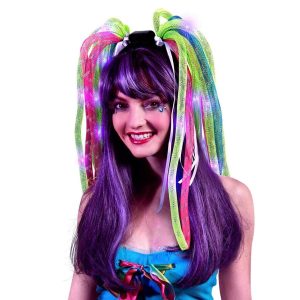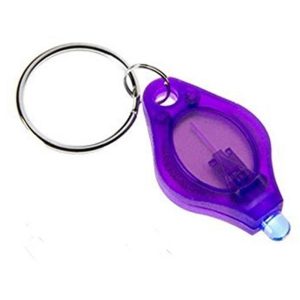10 Everyday Items You Didn’t Know Glow Under Black Light
Black lights (also known as UV lights) are often associated with nightclubs, forensic investigations, and art shows, but their use goes far beyond these environments. When exposed to UV light, certain substances absorb ultraviolet energy and re-emit it as visible light, creating an eerie glowing effect. What makes UV light fascinating is that it can reveal things that are invisible under normal lighting conditions—from hidden stains to chemical residues to unexpected fluorescent items.
In this blog, we’ll explore 10 everyday items you probably have at home or encounter regularly that glow unexpectedly under black light. Whether you want to explore the science behind fluorescence, check out cool party tricks, or experiment with UV light detection, these objects will surprise you!
![Led Flashing Noodle Dreads Headband Neon Model[1]](https://blinkee.com/blinkeeblog/wp-content/uploads/2024/10/LED-Flashing-Noodle-Dreads-Headband-Neon-Model1.jpeg)
1. Tonic Water
You’ve probably enjoyed tonic water in cocktails or soda, but did you know it glows bright blue under black light? The glow comes from quinine, a bitter compound added to tonic water. Quinine absorbs UV light and emits it as a vibrant blue fluorescence.
- Try it out: Pour tonic water into a glass and shine a black light over it. For extra fun, freeze it into glowing ice cubes for your next party!
2. Laundry Detergent and Whitening Agents
Many laundry detergents contain optical brighteners, which are chemicals designed to make clothes look whiter and brighter. These agents absorb UV light and re-emit it as blue light, which gives clothing a cleaner, crisper appearance.
- Fun experiment: Shine a black light on freshly washed clothes or detergent powder, and you’ll see the hidden glow! Some bleaches and fabric softeners also fluoresce.
3. Highlighters and Fluorescent Markers
If you’ve ever used highlighters to emphasize notes, you might have noticed that the ink looks especially vibrant under black light. This is because most highlighters contain fluorescent dyes that glow brilliantly in UV light, especially yellow, pink, and green colors.
- Classroom trick: Write secret messages using highlighters, then use a black light to reveal them!
4. Toothpaste with Whitening Properties
Certain types of toothpaste, especially those labeled as whitening, contain compounds like titanium dioxide or optical brighteners that fluoresce under UV light. This property helps whiten teeth by reflecting light more effectively.
- Test it out: Apply a dab of whitening toothpaste on a surface, shine a black light on it, and watch it glow a brilliant white or blue.
5. Vitamin B-12 Pills
If you have a bottle of Vitamin B-12 pills lying around, you’re in for a surprise—this vitamin glows bright yellow under black light! The fluorescence is due to the molecular structure of cyanocobalamin, the active form of B-12.
- Experiment idea: Crush a small pill in water and shine UV light over the solution to see it glow.
6. Paper Money and Security Features on IDs
Many types of paper currency include UV-reactive security threads to prevent counterfeiting. For example, U.S. dollars contain threads that glow green, blue, or yellow under UV light. Similarly, passports and driver’s licenses also have hidden UV features embedded in their designs.
- Try it yourself: Place a banknote or your ID card under a black light to reveal hidden patterns and threads.
7. Jellyfish and Other Marine Life
Nature offers some of the most stunning examples of fluorescence. Certain jellyfish, corals, and sea anemones glow under UV light, thanks to proteins that fluoresce. Marine biologists use black lights to study these animals’ behavior and health.
- Bonus fact: Some fish in pet stores, known as GloFish, are genetically modified to glow under black light, making them a fun addition to UV-lit aquariums.
8. Scorpions
Believe it or not, most species of scorpions fluoresce a bright blue-green color under black light. This glowing property is caused by certain compounds in their exoskeletons, though scientists are still studying the evolutionary purpose of this phenomenon.
- Safety note: If you’re camping or hiking, bring a UV flashlight along to check for scorpions at night!
9. Banana Peels
A banana peel glows blue under UV light once the fruit starts to ripen. This fluorescence occurs due to the breakdown of chlorophyll in the peel, producing compounds that react to UV light. Though invisible to us in normal light, insects such as fruit flies may use this glow to locate ripe bananas.
- Fun fact: This UV glow fades as the banana becomes overripe, offering an indicator of the fruit’s freshness.
10. Petroleum Jelly (Vaseline)
Petroleum jelly, such as Vaseline, has a strong bluish-white glow under black light. This effect occurs because the hydrocarbons in petroleum jelly fluoresce under UV exposure. This same property is also seen in some skincare products.
- DIY glow experiment: Coat a small object with Vaseline and shine a black light on it for a glowing effect. You can also use Vaseline to write invisible messages that glow under UV light.
Bonus: Other Fluorescent Surprises
- Eggshells: Some eggshells glow under UV light due to calcium deposits.
- Butter and Honey: Certain organic compounds in dairy products and honey glow faintly under UV light.
- Hot Sauce: Some brands of hot sauce contain fluorescent compounds like capsaicin, giving them a red or orange glow.
- Tattoos with UV Ink: Certain tattoo inks are designed to glow only under black light, creating hidden body art that’s perfect for UV-lit environments.
How to Explore the World of Fluorescence at Home
If this list has piqued your curiosity, here are some tips to start your own UV light exploration:
1. Get a UV Flashlight or Black Light
Handheld UV flashlights are affordable and easy to find. Choose one with 365nm or 395nm wavelengths for optimal results.
2. Create a UV Treasure Hunt
Use invisible ink pens or Vaseline to create hidden messages or clues for a fun treasure hunt. Participants can use black lights to reveal the hidden information.
3. Check for Scorpions or Bugs
If you live in a region with scorpions or other insects, take a UV flashlight outside at night to see if you can spot any glowing critters.
4. Test Everyday Objects in Your Home
Grab a UV flashlight and explore your home for unexpected fluorescence. You might be surprised by the things that glow!
Safety Precautions for Using UV Lights
While UV light is generally safe for occasional use, it’s important to take a few precautions:
- Avoid direct exposure to your eyes and skin for extended periods. Wear UV-protective glasses if using UV lights for long periods.
- Keep UV lights away from children and pets to prevent accidental exposure.
- Use UV lights in a dark environment to maximize fluorescence visibility.
Conclusion: Discover the Hidden Glow Around You
From the chemicals in laundry detergent to the glowing properties of bananas and jellyfish, UV light reveals a hidden world that goes unnoticed under regular lighting. With a simple black light or UV flashlight, you can explore these fascinating phenomena firsthand. Whether you’re looking to impress friends with glowing tonic water at a party or explore the forensic side of UV detection, these everyday items offer an easy way to experiment with fluorescence.
So grab a UV flashlight, dim the lights, and start your adventure—you never know what surprises might be hiding in plain sight!



